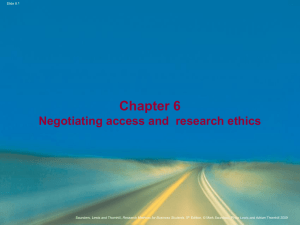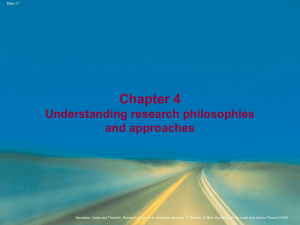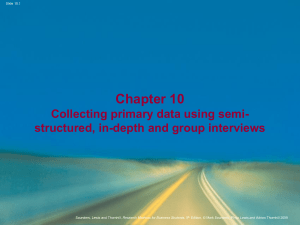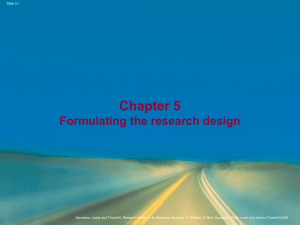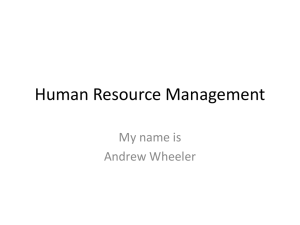Chapter 8 Using secondary data
advertisement
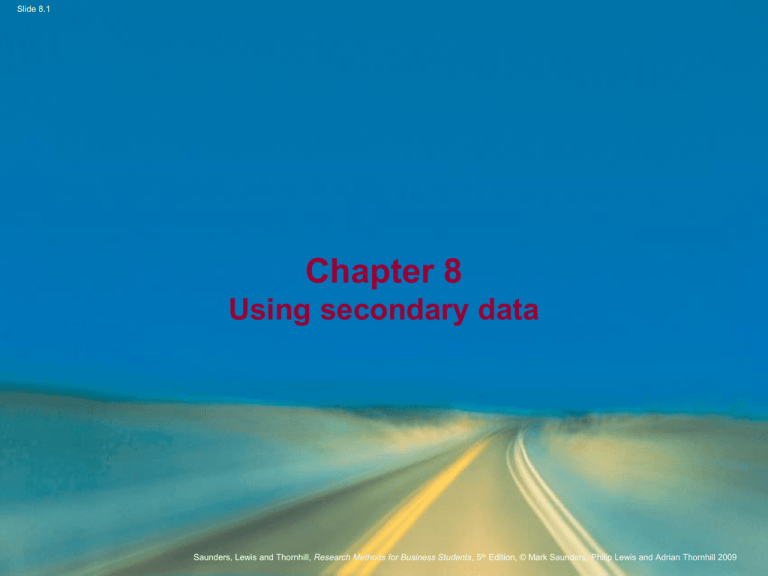
Slide 8.1 Chapter 8 Using secondary data Saunders, Lewis and Thornhill, Research Methods for Business Students, 5th Edition, © Mark Saunders, Philip Lewis and Adrian Thornhill 2009 Slide 8.2 Using secondary data for research (1) Types of secondary data • Documentary – written and non-written • Surveys – subtypes include: censuses, regular and ad hoc Saunders, Lewis and Thornhill, Research Methods for Business Students, 5th Edition, © Mark Saunders, Philip Lewis and Adrian Thornhill 2009 Slide 8.3 Using secondary data for research (2) Types of secondary data Figure 8.1 Types of secondary data Source: Saunders et al. (2006) Saunders, Lewis and Thornhill, Research Methods for Business Students, 5th Edition, © Mark Saunders, Philip Lewis and Adrian Thornhill 2009 Slide 8.4 Using secondary data for research (3) Multiple – source secondary data • Documentary , survey, or an amalgam of both • Times series for longitudinal studies • Cohort studies • Area-based data sets Saunders, Lewis and Thornhill, Research Methods for Business Students, 5th Edition, © Mark Saunders, Philip Lewis and Adrian Thornhill 2009 Slide 8.5 Locating secondary data Finding the data - a two stage process 1. Establishing that the required secondary data is available 2. Locating the precise data required Saunders, Lewis and Thornhill, Research Methods for Business Students, 5th Edition, © Mark Saunders, Philip Lewis and Adrian Thornhill 2009 Slide 8.6 Availability of secondary data (1) Sources • References in publications (books, journal articles) • Within organisations (unpublished sources) • Tertiary literature – ( indexes and catalogues in archives or online) Saunders, Lewis and Thornhill, Research Methods for Business Students, 5th Edition, © Mark Saunders, Philip Lewis and Adrian Thornhill 2009 Slide 8.7 Availability of secondary data (2) Finding secondary data • References in published guides (Table 8.1) • Data held by organisations • Data on the Internet (Table 8.2) Saunders, Lewis and Thornhill, Research Methods for Business Students, 5th Edition, © Mark Saunders, Philip Lewis and Adrian Thornhill 2009 Slide 8.8 Evaluating secondary data (1) Advantages • Fewer resource requirements • Unobtrusive • Longitudinal studies may be feasible • Provision of comparative and contextual data • Unforeseen discoveries may occur • Generally permanent and available Saunders, Lewis and Thornhill, Research Methods for Business Students, 5th Edition, © Mark Saunders, Philip Lewis and Adrian Thornhill 2009 Slide 8.9 Evaluating secondary data (2) Disadvantages • Purpose of data collection may not match the research needs • Access may be difficult or costly • Aggregations and definitions may be unsuitable • No real control over data quality • Initial purpose may affect data presentation Saunders, Lewis and Thornhill, Research Methods for Business Students, 5th Edition, © Mark Saunders, Philip Lewis and Adrian Thornhill 2009 Slide 8.10 Evaluating secondary data (3) Ensure that data sources • Enable the research question(s) to be answered • Enable research objectives to be met • Have greater benefits than their associated costs • Allow access for research Saunders, Lewis and Thornhill, Research Methods for Business Students, 5th Edition, © Mark Saunders, Philip Lewis and Adrian Thornhill 2009 Slide 8.11 Evaluating secondary data (3) Evaluating potential secondary data sources Source: Saunders et al. (2009) Figure 8.2 Evaluating potential secondary data sources Saunders, Lewis and Thornhill, Research Methods for Business Students, 5th Edition, © Mark Saunders, Philip Lewis and Adrian Thornhill 2009 Slide 8.12 Suitability of secondary data (1) Overall suitability: points to consider • Precise suitability, including reliability and validity - assessment of collection methods - clear explanation of collection techniques • Measurement validity • Measurement bias and deliberate distortion Saunders, Lewis and Thornhill, Research Methods for Business Students, 5th Edition, © Mark Saunders, Philip Lewis and Adrian Thornhill 2009 Slide 8.13 Suitability of secondary data (2) Overall suitability: points to consider • Coverage and unmeasured variables - ensure exclusion of unwanted data - ensure sufficient data remain for analysis • Costs and benefits Saunders, Lewis and Thornhill, Research Methods for Business Students, 5th Edition, © Mark Saunders, Philip Lewis and Adrian Thornhill 2009 Slide 8.14 Evaluating your secondary data sources Checklist Box 8.9 Complete the Checklist in Box 8.9 to help you evaluate your secondary data sources Saunders et al. (2009) Saunders, Lewis and Thornhill, Research Methods for Business Students, 5th Edition, © Mark Saunders, Philip Lewis and Adrian Thornhill 2009 Slide 8.15 Summary: Chapter 8 • Secondary data consists of three main types documentary, survey and multiple sources • The data can be used in a variety of ways • Secondary data may be less current and collected for a purpose that does not match your research question(s) • Secondary data needs to be located and its availability established • Data sources should be assessed for suitability, measurement validity and coverage Saunders, Lewis and Thornhill, Research Methods for Business Students, 5th Edition, © Mark Saunders, Philip Lewis and Adrian Thornhill 2009 Slide 8.16 Summary: Chapter 8 • Evaluation of secondary data should include reliability and any measurement bias • Costs and benefits of using secondary data should be evaluated and compared with alternative sources • Although secondary data may contain some bias, it can help to answer your research question • Remember to check the research project assessment regulations regarding the use of secondary data Saunders, Lewis and Thornhill, Research Methods for Business Students, 5th Edition, © Mark Saunders, Philip Lewis and Adrian Thornhill 2009
